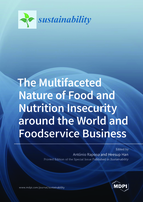The Multifaceted Nature of Food and Nutrition Insecurity around the World and Foodservice Business
A special issue of Sustainability (ISSN 2071-1050). This special issue belongs to the section "Sustainable Food".
Deadline for manuscript submissions: closed (5 February 2022) | Viewed by 43915
Special Issue Editors
Interests: food safety; food security; food innovation; natural food products; nutrition; public health
Special Issues, Collections and Topics in MDPI journals
Interests: food quality; service quality; restaurants; cafés; hotels; cruises; green consumption; tourism; sustainable destination development
Special Issues, Collections and Topics in MDPI journals
Special Issue Information
Dear Colleagues,
The international concept of food security is a situation where all people have physical, social and economic access at all times to sufficient, safe and nutritious food that meets their dietary needs and food preferences for an active and healthy life. All four parameters (availability, access, utilization and stability) should therefore be measured to determine food security status.
The matter of hunger, which is generally equated with access to inadequate amounts of food and compromised food quality to reach the required daily intake, is addressed by both food and nutrient insecurity. In the past, the food security term has been the issue of food availability and accessibility, and the utilization aspect has been identified as essential more recently.
Nutrition, on the other hand, centered on consuming adequate diversified meals and nutrient absorption that could contribute to other forms of malnutrition, such as hidden hunger and obesity.
Food quality is another critical issue across the globe. In their daily life, an individual eats at a restaurant/café/hotel and seeks for better quality food and service. Quality performance of food and service at a foodservice operation contributes to making one’s consumption happier and his/her life healthier.
Taking into account these premises, this Special Issue aims to present original research articles, reviews, and short communications concerning the following topics:
- Agriculture and food security
- Agri-tourism and its potential to assist with food security
- Business–science cooperation to advance food security
- Competing demands and tradeoffs for land and water resources
- Consumer behavior, nutritional security and food assistance programs
- Food and health
- Global and local analyses of food security and its drivers
- Global governance and food security
- Infectious and non-infectious diseases and food security
- Reducing food loss and waste
- Reducing risks to food production and distribution from climate change
- Supply chains and food security
- Technological breakthroughs to help feed globe
- Tourism food security relationship
- Urbanization, food value chains, and the sustainable, secure sourcing of food
- Food and service quality at food catering establishments
- Consumer behavior at foodservice operations (restaurants, cafés, hotels)
Dr. António Raposo
Prof. Dr. Heesup Han
Guest Editors
Manuscript Submission Information
Manuscripts should be submitted online at www.mdpi.com by registering and logging in to this website. Once you are registered, click here to go to the submission form. Manuscripts can be submitted until the deadline. All submissions that pass pre-check are peer-reviewed. Accepted papers will be published continuously in the journal (as soon as accepted) and will be listed together on the special issue website. Research articles, review articles as well as short communications are invited. For planned papers, a title and short abstract (about 100 words) can be sent to the Editorial Office for announcement on this website.
Submitted manuscripts should not have been published previously, nor be under consideration for publication elsewhere (except conference proceedings papers). All manuscripts are thoroughly refereed through a single-blind peer-review process. A guide for authors and other relevant information for submission of manuscripts is available on the Instructions for Authors page. Sustainability is an international peer-reviewed open access semimonthly journal published by MDPI.
Please visit the Instructions for Authors page before submitting a manuscript. The Article Processing Charge (APC) for publication in this open access journal is 2400 CHF (Swiss Francs). Submitted papers should be well formatted and use good English. Authors may use MDPI's English editing service prior to publication or during author revisions.
Keywords
- agriculture
- consumer behavior
- food habits
- food industry
- food policy
- food safety and quality
- food security
- food industry and technology
- nutritional diseases
- tourism
- service quality at restaurants/cafés/hotels







